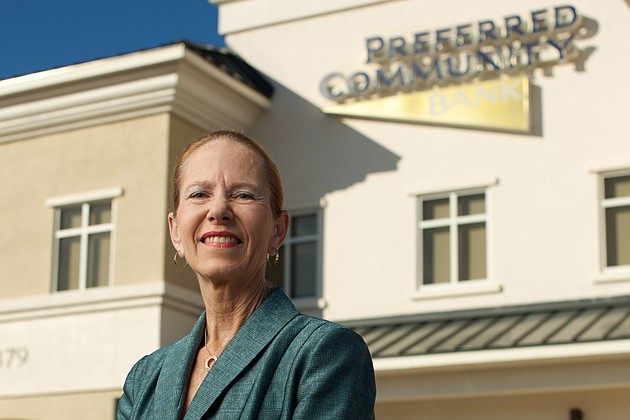Conventional wisdom during the depths of the economic downturn held that small community banks might never survive the real estate collapse.
Indeed, real estate lending is the bread and butter of community banks in Florida. The collapse in values and subsequent wave of residential and commercial foreclosures during the real estate bust forced regulators to close the weakest banks while others lost millions of dollars.
But now, the fact that small community banks have weathered the storm to become profitable again indicates there may be room for small lenders on the Gulf Coast after all.
Together, the 45 banks headquartered from the Tampa Bay region to Naples posted $78 million of net income in the third quarter, up 14% from the same quarter in 2012. For the year-to-date through Sept. 30, profits rose 21% to $215 million compared with the first nine months of 2012.
“The economy recovering hasn't hurt,” says Brenda O'Neil, chairwoman and CEO of Preferred Community Bank in Fort Myers. For the year-to-date through Sept. 30, Preferred Community swung to a profit of $223,000 from a loss of $711,000 in the first nine months of 2012.
Many banks no longer have to set reserves aside to cover bad loans. In addition, the expenses associated with foreclosures such as legal and property management fees declined. “As you get rid of those problem assets, those numbers start to come back in line,” says O'Neil, whose bank recently raised $2.9 million in additional capital.
 Even with the additional regulatory burdens from the government, O'Neil doesn't buy into the argument that bigger is better. Preferred Community reported nearly $80 million in assets on Sept. 30, up 4.3% from one year ago. “Good, core profitability is possible at whatever size you are,” she says.
Even with the additional regulatory burdens from the government, O'Neil doesn't buy into the argument that bigger is better. Preferred Community reported nearly $80 million in assets on Sept. 30, up 4.3% from one year ago. “Good, core profitability is possible at whatever size you are,” she says.
Affordable systems to help small banks comply with government regulations will be available, says Lew Albert, the CEO of Calusa National Bank. “There will be a window in communities that are underserved by local decision-making,” he says.
The key for smaller community banks is to find a niche, says Lewis Benner Jr., the president and CEO of 1st Manatee Bank in Parrish, which reported $103 million in assets on Sept. 30. For example, 1st Manatee started making government-backed loans to small businesses in the Parrish area. The bank has also benefited from the fact that there are just two community banks chartered in Manatee County, Benner says.
While many of the Gulf Coast's smaller banks have been profitable, the larger banks accounted for the lion's share of the profits. In the third quarter, the five biggest banks on the Gulf Coast earned 93% of the profits.
For example, Raymond James Bank posted $43.7 million in profits in the third quarter, which was more than half of the total profits of all 45 banks on the Gulf Coast. Raymond James Bank is the area's largest bank with $10.5 billion in assets. Executives with the bank couldn't be reached to discuss the results.
“The regulatory environment is not favorable for smaller banks,” says Gary Tice, chairman and CEO of First National Bank of the Gulf Coast in Naples, which reported $668 million in assets as of Sept. 30. “I know what it takes from a compliance standpoint. I have five full-time compliance people.”
Tice says to give shareholders a meaningful return and overcome significant expenses for regulatory compliance, banks need to grow their assets to between $2 billion and $4 billion. First National could reach the $2 billion mark within the next two to three years, Tice says.
“Getting scale is critical,” says Joseph Caballero, the president and CEO of Gulfshore Bank in Tampa. The bank reported assets of $242 million on Sept. 30, but Caballero says he hopes to double that in the next three to five years.
Gulfshore Bank recently raised close to $6 million in new capital and plans to raise another $1 million. “We've been able to raise capital and that's enabled us to grow,” says Caballero.
A few banks reported particularly strong profits because of one-time events that make year-over-year comparisons difficult. For example, USAmeribank recently sold its insurance division for $10 million. “We booked a pretty sizable gain,” says Joseph Chillura, the CEO of USAmeribank in Largo, which reported a 137% increase in net income in the third quarter compared with the same quarter in 2012.
At First National, tax credits boosted the bank's net income a dramatic 1,324% for the year-to-date through Sept. 30 compared with the first nine months of 2012. That's going to make future comparisons difficult. “Our bottom line going forward is not going to look as good as it did in the past,” says Tice. “Our concentration is on adequate earnings, but [asset] growth is the No. 1 driver for the next few years.”




 Even with the additional regulatory burdens from the government, O'Neil doesn't buy into the argument that bigger is better. Preferred Community reported nearly $80 million in assets on Sept. 30, up 4.3% from one year ago. “Good, core profitability is possible at whatever size you are,” she says.
Even with the additional regulatory burdens from the government, O'Neil doesn't buy into the argument that bigger is better. Preferred Community reported nearly $80 million in assets on Sept. 30, up 4.3% from one year ago. “Good, core profitability is possible at whatever size you are,” she says.





